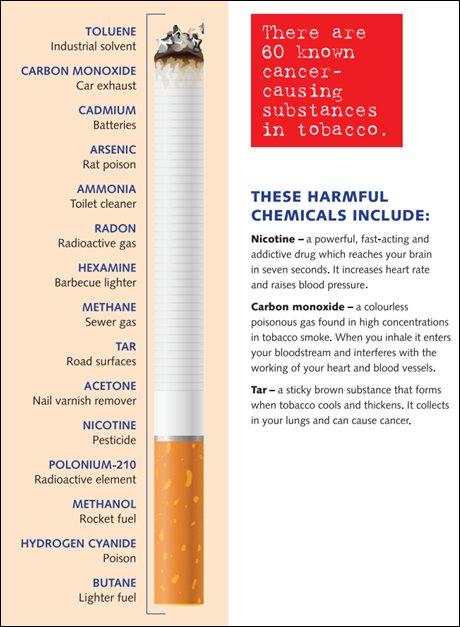How tobacco smoke can cause 16 types of cancers
Tobacco smoke contains over 7,000 chemicals! Many of these are carcinogens as well as being radioactive! Smoking increases a person’s risk of developing up to 16 different types of cancers, including:
- Lung
- Mouth
- Throat
- Oesophagus
- Stomach
- Bowel
- Liver
- Pancreas
- Nasal cavity
- Voice box
- Cervix
- Ovary
- Bladder
- Kidney
- Urete,
- and bone marrow (myeloid leukaemia).
Why would you be so unkind to your body and your skin? Why do some people continue to smoke when there is so much evidence behind its harmful effects?
Smoking and Wrinkles
Yes smoking damages elastin and collagen in the skin. This makes the skin look dry and wrinkly all over with more liver brown spots. It constricts the blood vessels, preventing oxygen from reaching the skin cells and also causes hardening of the arteries…putting you at a higher risk of stroke and heart attack.
Basically, smokers look much older for their years because their cellular structure is aging at a faster rate. Not only that, but in Australia, one packet of cigarettes (average spend per day…ie 7 packets per week) ranges from between $28 and $34 for 25 cigarettes….that’s around $200 per week! Money that could be better spent on more exciting things….like a holiday in the sun!
Smoking may be one of the factors that can lead to the development of Hodgkins lymphoma or at least increase its risk.
Studies show that…
In a study carried out between Hodgkins lymphoma sufferers and healthy individuals, the incidence of smoking were measured. The results turned out to be interesting:
•Smokers tend to have a 40% higher risk of developing Hodgkin lymphoma.
•The risk was higher among current smokers (those who have been smoking within the last two years) than among those who have quit smoking.
•The risk reduces to the same level as non-smokers about 10 years after quitting.
That’s good news for quitters and a reason to consider doing so if you are still a smoker! A new study led by researchers from the Mayo Clinic in collaboration with six other U.S. institutions has found that Non-Hodgkins Lymphoma patients who smoked and consumed alcohol or were obese before their cancer diagnosis had a poorer overall survival, compared to patients who did not have these lifestyle choices. For example:
•Non-Hodgkin’s lymphoma patients with a 20-plus-year history of smoking had a 76% higher risk of death compared to those who never smoked
•Patients who consumed more than 43 grams of alcohol per week had a 55 percent higher risk of death compared to nondrinkers;
•Obese patients (defined as a body mass index of 30 or higher) had a 32 percent higher risk of death compared to patients with normal weight for their height.
Increased Risk
Research continues to find an increased risk among smokers for Hodgkin lymphoma. Cancer Research UK says it amounts to 10-15% higher risk for people who smoked compared with people who have never smoked. But the risk is mostly associated with people who are currently smoking. It is also more pronounced the older you get, which may relate to the number of years someone has been smoking.
Shocking Ingredients in Cigarettes
Tobacco smoke is both toxic and addictive.
- Nicotine
Nicotine is a colourless, poisonous alkaloid derived from the tobacco plant. It is a powerful drug, which affects the brain and quickly becomes addictive. - Tar
‘Tar’ is the term used to describe the toxic chemicals found in cigarettes. It’s a sticky brown substance that forms when tobacco cools and condenses. It collects in the lungs and can cause CANCER. - Carbon monoxide
An odourless, colourless gas that is released from burning tobacco. When it is inhaled it enters the blood stream and interferes with the working of the heart and the blood vessels. Up to 15% of a smoker’s blood can be carrying carbon monoxide instead of oxygen. - Arsenic
Arsenic-containing pesticides used in tobacco farming occur in small quantities in cigarette smoke. Arsenic is commonly found in rat poison! - Ammonia
Ammonia is a toxic, colourless gas with a sharp odour. Ammonia compounds are commonly used in cleaning products and fertilisers. Also used to boost the impact of nicotine in manufactured cigarettes. - Acetone Fragrant
volatile liquid ketone, used as a solvent. Nail polish remover is a solvent, for example! - Toluene
Toluene is a highly toxic chemical. Industrial uses include rubbers, oils, resins, adhesives, inks, detergents, dyes and explosives. - Methylamine
Chemical found in tanning lotion. - Pesticides
A number of pesticides (toxic chemicals used to kill pests, usually insects) are present in cigarette smoke. These pesticides find their way into cigarettes because they’re used on tobacco plants as they are growing. - Polonium – 210
Radioactive element – used in nuclear weapons as well as an atomic heat source. - Methanol
Fuel used in the aviation industry.Are these really what you want in your body? There’s no better time than NOW, to clear out and cleanse the toxic chemicals from the body.

What Vitamins & Herbs Can I take to Detox the Lungs?
After you’ve made the brave decision to stop smoking, there are specific vitamins that can help your lungs to filter out the toxins. These are Vitamins C, E, D, CoQ10 and Essential Fatty Acids.
Herbal medicines include: Golden seal, Echinacea, Ginger, Garlic, Comfrey, Nigella and Astragalis. Your lungs can detox and rebuild healthy tissue (especially the cilia hair-like projections that are damaged) and a healthy body will follow. This may take a few weeks to several months but whatever it is – start NOW – it’s worth it.
Also read: Detoxifying your life Best way you can

